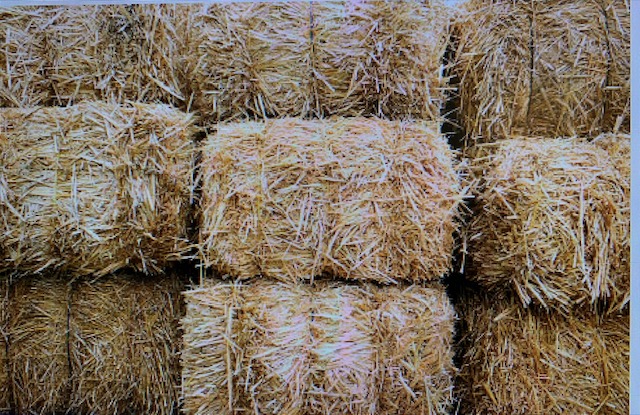By Mario Villarino, Extension Agent For Agriculture & Natural Resources, Hopkins County, [email protected]
Recently, I got a visit from a beef producer looking for hay. Desperate, she was locating hay far away from Hopkins County. Her concerned was poisonous compounds on the hay made of drought stressed plants. Immediately my concern was nitrate accumulation.

Ammonium nitrogen is the preferred form of nitrogen for plant growth, but nitrate nitrogen is the form primarily taken up by plants. Even when ammonium and urea based fertilizers are applied, most of the nitrogen taken up by plants is in the nitrate form because soil microorganisms quickly convert ammonium nitrogen to nitrate nitrogen. Nitrates are extremely soluble in water and are easily absorbed by plant roots along with soil moisture. Normally, plants reduce nitrates to ammonium ions and then assimilate them into amino acids and other proteins. This process, called nitrate reductase, occurs in the roots of some grasses such as bermudagrass, and in the leaves, stems and stalks of plants such as corn or sorghum.
When plants are stressed (for example, by drought) this process slows or stops, allowing nitrates to accumulate. Here are some conditions that cause nitrate accumulation: When the temperature is high and moisture is adequate, plants may undergo a process called photorespiration. Photorespiration produces carbon dioxide rather than assimilating carbon into energy building blocks (i.e., sugars, carbohydrates, etc.). This may cause nitrates to accumulate. When the soil contains nitrate nitrogen but little soil moisture, nitrates are highly concentrated in the water plants take up. Plants don’t have enough water to continue growing and nitrates accumulate. Herbicide injury can limit the conversion and assimilation of nitrates in plants. After herbicide applications, check the field, especially field edges, for forage plants affected by off-target herbicide drift. Three to 5 days of active growth are needed to significantly reduce nitrate levels in plants.
While these plants are the ones most likely to accumulate nitrates, nitrates are present to some degree in all forages, including bermudagrasses. Nitrates are nonvolatile and remain in nonensiled plants after cutting, curing and baling. Nitrates are soluble in plant tissues and will leach from the plant during sustained rainfall. However, weathering significantly reduces the nutritional value of hay bales so it is not a good way to manage nitrates. Furthermore, the movement of leached nitrates within a weathered bale may limit the use of the forage. Research at the Texas Veterinary Medical Diagnostic Laboratory (TVMDL) at Texas A&M University has found that it is safe to feed forage containing 1% nitrate (on a dry-matter basis) to healthy ruminants. Forage with a higher percentage of nitrate could be fed if it is ground and mixed with nitrate-free forage to reduce overall nitrate levels to less than 1% (dry-matter basis). Forage containing 0.5 to 1% nitrate should not be fed to weakened cattle unless your veterinarian has approved it. The 1% nitrate level set by the TVMDL is significantly higher than levels suggested by other southern universities. This level assumes that cattle are healthy, well conditioned, and being fed a high-energy diet.

If forage contains too much nitrate, the animals cannot complete the conversion and nitrite levels build up. Nitrite is adsorbed directly into the bloodstream through the rumen wall, where it combines with hemoglobin to form methhemoglobin. Hemoglobin carries oxygen in the blood, but methhemoglobin does not. The formation of methhemoglobin can cause an animal to die from asphyxiation, or lack of oxygen. The animal’s blood turns brown instead of the normal bright red. Monogastrics (i.e., horses, mules, swine, etc.) are less sensitive to nitrate toxicity than ruminants. An animal’s conditioning affects its ability to assimilate or tolerate nitrates, so consult your veterinarian before feeding forage that contains nitrates.
The best way to manage forages that contain nitrates is determined by the forage type and the harvest method. All the management systems described here should be used in tandem with proper sampling and analysis. There are fewer options for managing baled forages that contain nitrates. The safest method is to grind the bales and thoroughly mix them with hay that is free of nitrate. There should be enough good forage in the mix to reduce the nitrate level to less than 1%. It is best to mix similar forage types so that the feed has a uniform particle size distribution. The optimum size is dictated by stem size; in general, the smaller the better. A handful of ground and mixed feed should contain portions of all plant parts from all forages used in the mix. The uniform size will help limit selective feeding by livestock. This grinding and mixing method should not be used for forages containing more than 2.5% nitrate. If nitrate levels are higher than 2.5% or there is no way to grind and mix the forage, do not use the baled forage for livestock feed or bedding.
For more information on this or any other agricultural topic please contact the Hopkins County Extension Office at 903-885-3443 or email me at [email protected].





